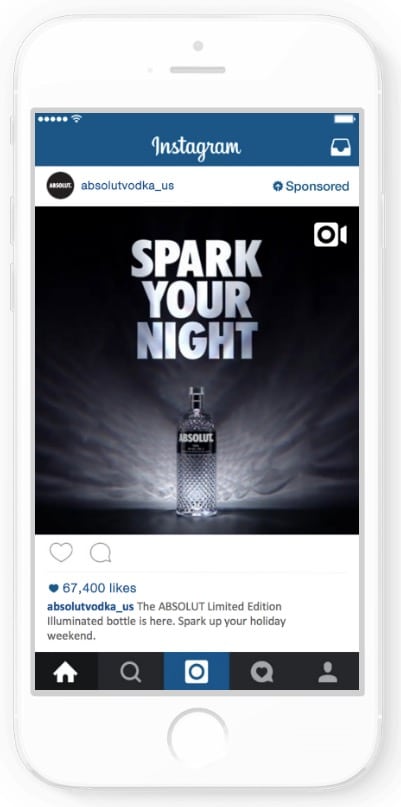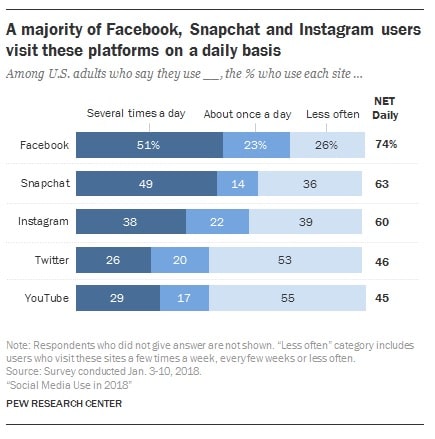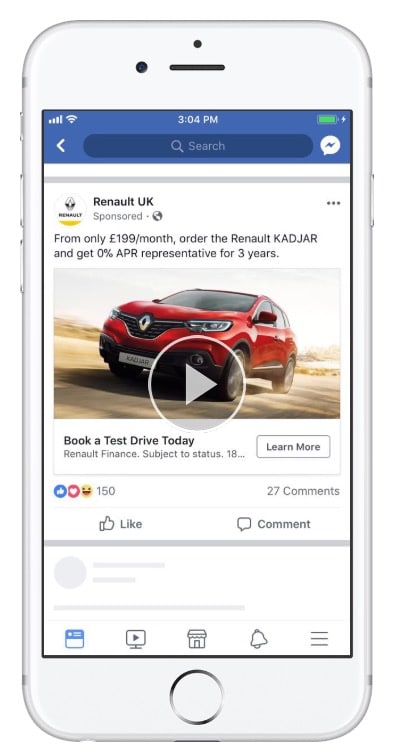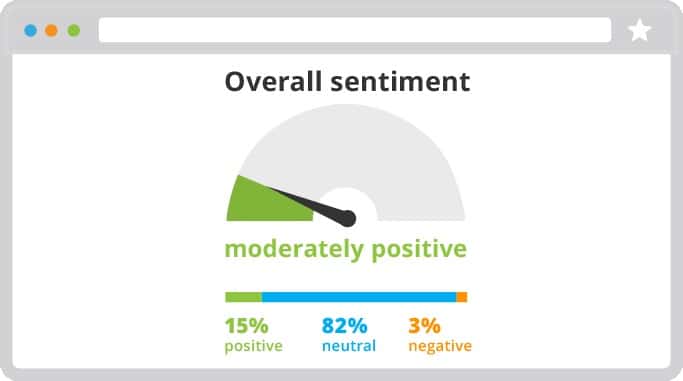How Can Social Media Benefit Your Business?
It’s hard to believe that today more than 3 billion people use social networks around the globe. Many companies are using social to engage people with their brands. Sherpa Marketing discovered that more people follow brands on social media than follow celebrities. On Instagram alone, 80 percent of people follow at least one business.
If you’re not taking advantage of social, you’re missing out on a fast, inexpensive, and effective way to reach almost half the world’s population.
How Can Your Business Benefit by Using Social Media:
- Building Your Brand
- Growing Your Business
- Creating and Distributing Content
- Communicating Your Message
- Gaining Business Insights
- Advertising Your Business
Benefits of Brand Building Using Social Media
Social Media Humanize’s Your Brand
According to a UK study from Trinity Mirror Solutions, more than half of adults do not trust a brand until they see “real-world proof”. To gain the trust of just 50% of adults, your brand must constantly prove that it’s keeping its promises.
To build trust and connect with customers, you have to engage your visitor’s with the human side of your brand. Do you engage visitors with your brand values? Do you even have brand values? Do you look out for the best interests of your customers and employees? Does your product not only meet, but exceed your customers expectations?
Creating real human connections is the main benefit of using social media for business engagement. We call these Meaningful Relationship Moments. Introduce your followers to your companies key employees. This allows you to also showcase how existing customers are using and benefiting from your products.
A social media advocacy program can be a great way to humanize your brand.
Increase Your Brand Awareness
Since nearly half of the world’s population uses social media, it makes social media the natural place to reach new and highly targeted potential customers.
Do you believe that people only connect with brands they already know on social media? You need to understand that 60 percent of Instagram users say they discover new products on the platform.

When Absolut Vodka ran an Instagram campaign to promote its limited edition Spark bottle, the company achieved a five-point lift in brand awareness.
Make Your Brand a Thought Leader
No matter what industry your business is in, social media offers the opportunity to establish your brand as a thought leader. Become the go-to source for information on topics related to your niche.
Though leadership, along with brand advocacy is a great way to build consumer trust. In fact, LinkedIn research in partnership with Edelman shows that marketers underestimate just how much thought leadership can impact trust consumer trust.
Almost half of B2B marketers surveyed believed their thought leadership would build trust in their companies. However, more than 80 percent of buyers said thought leadership builds trust.

The 2018 Edelman Trust Barometer also found that 63 percent of people trust technical experts, compared to only 42 percent of people who trust businesses.
LinkedIn is a great social network to focus on when aiming to establish yourself as a thought leader. With more than 550 million users LinkedIn regularly ranks as the most trusted social network out of Facebook, Twitter, Snapchat, Instagram, LinkedIn, and YouTube.
While LinkedIn isn’t the largest social media network, it’s highly trusted by those that use it. LinkedIn provides a unique opportunity to have your voice heard and bolster your standing as an expert in your field.
I’m often asked, “What type of content should I post to LinkedIn?” While at it’s core, LinkedIn is a social network, two types of posts that may engage visitors better on LinkedIn than other social networks include:
Engage Social Media Users
Most social media users log into their accounts at least once per day, according to Pew Research Center, and many people are checking social multiple times per day.
Every time your fans and followers log into their social media accounts gives you a new opportunity to connect and engage with them.

You have to keep your social posts engaging and informative. If they find it useful, your followers will look forward to your new content in their feeds. Engaging them like this will keep you at the top of their mind. This will also make you their first stop when they’re ready to buy.
How Can Social Media Help You Grow?
Use Social Media to Increase Website Traffic
Social media posts and ads are two ways you can drive traffic to your website. Sharing great content from your blog or website to your social channels is a great way to engage readers as soon as you publish a new post
It’s important to not only post your great content. It’s important to engage your readers, developing a conversation with others, sharing ideas and opinions.
Participating in social chats is also be a great way to increase your visibility. You need to get attention from new people, showcase your expertise, and drive traffic to your website. The key for you is to offer value in the chat, don’t be too promotional.
Just make sure your website address is included in all of your social media profiles so that people who want to learn more about you can do so easily. Even better use a pinned post during the chat, highlighting a relevant landing page on your website.
Use Social Media to Generate Leads
Social media offers an easy and low-commitment way for potential customers to express interest in your business and your products. Lead generation is such an important benefit of social media for business that many social networks offer advertising formats specifically designed to collect leads.
For example, Renault Europe used Facebook lead generation ads allowing people test driving a new model to book their test drive directly from Facebook, with just a couple of taps.
The ads had a 7.9 times lower cost per lead than ads linking to a form on the car manufacturer’s website.

Use Social Media to Boost Sales
No matter what you sell, social media can help you sell it. Your social accounts are an indespensable part of your sales funnel.
As social media use continues to grow and social sales tools evolve, social networks will become increasingly important for product search and ecommerce. Now is the time to align your social marketing and sales goals.
For individual sales professionals, social selling is already a critical tool.
Influencer Word-of-Mouth Drives Sales
Word of mouth drives 20 to 50 percent of purchasing decisions. You build your brand awareness and credibility when you get people talking about your product or company on social media. This also helps you set yourself up for future sales.
One key way to drive social word of mouth is to partner with influencers who have a large following on social media and can draw the attention of their following to your brand.
Research from Nielsen, Carat, and YouTube shows that collaborating with an influencer can give your brand four times more lift in brand familiarity than collaborating with a celebrity.
Benefits of Social Media for Content Creation and Distribution
Promote Your Content on Social Media
Promoting your content on social channels is a great way to get your content in front of new people, proving your expertise and growing your credibility and audience.
For example, Adobe used LinkedIn Sponsored Content to showcase its research, including infographics and videos.
Marketing decisions-makers exposed to Adobe’s promoted content were 50 percent more likely to view Adobe as shaping the future of digital marketing and 79 percent more likely to agree that Adobe could help them optimize media spend.
To maximize the social media for business benefits, make sure to have a content marketing plan in place.
Source Your Content for Social Media
There are two key ways your business can source content on social media:
- Source ideas: Ask your followers what they want, or engage in social listening, to come up with ideas for content you can create yourself. Give people what they’re asking for. It’s a sure way to create content that people will want to read and share.
- Source material for posts: Create a contest or use a hashtag to develop user-generated content (UGC) you can share. Getting your followers involved can build excitement about your brand while also providing you with a library of social posts to share over time.
How much content can you get through a UGC campaign? Check out the #wanderlustcontest hashtag from National Geographic, which has generated more than 60,000 posts.
Use Social Media to Go Viral
Your content is exposed to new audiences as people begin liking, commenting on, and sharing your social posts with their friends and followers. Going viral takes this concept one step further.
As influencers share your content across their network, and their networks follow suit, your content can spread across the internet. This could result in thousands or even millions of shares.
This exposure is beneficial to your brand because all those shares, likes, and comments show the existing connections with your brand. If I see that my friend likes your article, I may be inclined to check out what you have to say. Even if I’ve never heard of your company before.
A friend’s social sharing is a pre-screening and acceptance of your content. Today there is more content than any one person could ever consume, we all click on and engage with some of the content that our friend’s like or share.
Going Viral is not easy, however without social media it would be nearly impossible.
Manage Your Reputation Using Social Media
Your community is already talking about your brand on social media. You need to get ahead of your competition, using social listening will to help you discover critical issues in social posts about your brand before they turn into something major.
Is someone saying something about your business that’s not true? You have to share your side of the story. But do it in a polite, professional way. Is someone praising your brand? Express your thanks and draw attention to their kind words.
The important thing to remember, your content should be geared to establishing a positive conversation with your audience that will highlight your brand.
Social Media Makes Communication Easier
Engage Your Audience Using Social Media
Social media networks give you the unique opportunity to interact directly with your customers and fans. Using analytics it has become possible to personalize your message targeting specific customers. Social media also gives your audience the ability to interact directly with your brand.
Social media is unique in that it allows a direct conversation between your brand and your audience. This ability to establish two-way communications is very different from any past media enagement opportunities.
Using traditional media in the past offered only one-way communications from your brand to your audience. These were hit-or-miss because of their inability to target small groups effectively.
You have to be engaged if you want your customers and followers to be engaged. Your goal is to establish a conversation with your audience. Do so by actively responding to comments and questions on your own social media posts in a way that’s appropriate to your brand.
You can also use social media monitoring to keep an eye on what people are saying across the social web. Do you use analytics to measure your engagement success?
Use Social Media for Crisis Management
When a Philadelphia Starbucks store had two black men arrested, the hashtag #BoycottStarbucks quickly went viral. Starbucks was experiencing any companies worst nightmare. The #BoycottStarbucks hashtag was used more than 100,000 times in just three days. That would officially qualify as a crisis.
Starbucks, to its credit, responded quickly. After their first apology, the company followed up with several more statements on social media. Starbucks then announced that it would close all of its stores for a day of racial-bias training.

Only time will determine if there are long-term negative effects for the Starbucks brand from this incident. However, the fall-out would have been worse if they had not taken immediate and appropriate steps to address their crisis on social media.
Social media is primarily used for building your brand recognition and credibility. However it does have another critical use, giving you an effective method to reduce damage to your brand during a social media fueled crisis. Does your company have a plan in place for dealing with a serious crisis affecting your brand?
While small brands may not have a crisis blow up to such a large scale, even a small number of negative shares could be devastating to your brand. Silence is not an option when it comes to responding to a crisis on social media. Maintaining well managed social accounts and having a plan in place can help make sure you’re present and ready to engage if the worst occurs.
Customer Service Needs to be a Great Experience
It seems to just be common sense that your business must have good customer service. But how valuable is it really? Could great customer service actually make you more money?
Today, people expect your brand to be available on social media. Consumers are increasingly turning to social media to resolve their customer service issues. Are you prepared to respond to their concerns?
Research published in the Harvard Business Review shows that brands who aren’t meeting those expectations are damaging their bottom line. It’s not all bad news though. It’s a great opportunity for you to turn those angry customers into loyal ones.

The HBR research, looking specifically at Tweets is eye-opening. The research shows that customers who receive a response to their Tweet would be willing to spend more with the brand on a later purchase.
Especially if they get a response within five minutes. This is true even when the initial Tweet was strictly a complaint. How quickly do you respond to inquiries or complaints?
Benefits of Social Media for Gaining Insights
Monitor Conversations Relevant to Your Brand
Above, we mentioned social media monitoring is an important part of understanding your audience engagement. But it’s also an important source of intelligence about your brand, your competitors, and your niche. Do you follow your competitor’s on social media? Why not?
Analytics Help You Understand Your Customers
Social media generates huge amounts of real time data about your visitors and your customers. Have you thought about how you could use this data? Understanding the gathered information could help you make smarter, and more informed business decisions.
The social networks all offer built-in analytics that provide you with demographic information about the people interacting with your social media account. Use this information to help you tailor your strategy to better engage your audience.
Gauge Social Sentiment About Your Brand
Lots of mentions on social media is a good thing, right? Yes, in the majority of interactions. However, if you’re getting lots of negative mentions, you need to quickly figure out what’s gone wrong and address the problem.
Nick Martin, of Hootsuite defines social media sentiment as “the perceived positive or negative mood being portrayed in a social media post or engagement.”

While it’s important to know how much people are talking about your brand online, it also matters what people are actually saying about your brand. You should be engaging both the negative and positive commentors in a conversation.
Know What Your Competition is Doing
It’s important to know what people are saying about your competitors. By tracking mentions of your competitors you might find weaknesses with their products or services. Knowing about their failure, allows you to address it and reach out with a solution. Doing so could win you new customers.
Uber Canada had a great idea to deliver free ice cream for a day in Vancouver. This should have been a huge win for Uber, because who wouldn’t like free ice cream. Unfortunately things went spectacularly wrong. The success of Uber’s promotion was overwhelming. Uber was unprepared to meet the demand.
Uber failed because people couldn’t get their free ice cream. Because people were not happy about Uber’s failure to perform. These unhappy people took to social media to vent their frustrations and complain about Uber’s failure.

The folks at Skip The Dishes saw an opportunity and reached out to people complaining on social media about Ubers failure to deliver. They offered a free ice cream delivery of their own, in the form of a Skip The Dishes credit.
All those Uber haters quickly turned into Skip The Dishes fans, and potential new customers. To get your free ice cream you had to create a Skip The Dishes Account. Uber failed because they oversold the idea of free ice cream while Skip The Dishes found a clever way to profit from Uber’s failure.
Monitoring your competition on social media also means you’ll be aware when your competitors launch new products, run promotions, and release new reports or data. All valuable and actionable information.
Know What’s Happening in Your Industry
Things change quickly in the business world, however in the online world changes happen faster than ever. You need to be aware of these changes and be able to react to protect your brand in a timely manner. You can’t afford to get left behind.
You have to keep your virtual ear to the ground. Using social listening ensures that you’re informed about upcoming industry changes that could affect the way you do business.
Benefits of Social Media for Advertising
Embrace and Use Targeted Advertising
Great Social Media ads are an inexpensive way to promote your business and distribute your content. They also offer powerful targeting options so you can reach the right audience and make the most of your budget.
Savvy marketers have embraced this key benefit of social media for business: Marketers spent twice as much on Social Media ads in 2018 as they did on newspaper advertising.
With ad targeting options including Facebook demographic information, geography, language, and even online behaviors, you can craft specific messages that best speak to different groups of potential customers, and only pay for the exact viewers you want to reach.
Retargeting Turns Visitors Into Customers
Nearly 70 percent of online shopping carts are abandoned, never completing the transaction. Why do you think that happens? Have you ever abandoned a shopping cart before completing the transaction? Why did you abandon your cart?.
The people who have abandoned products in your shopping cart are your prime potential customers. They have already found your website. They have browsed your products. They even made a decision to add something to their cart.

You were so close to your goal. Why do you think your customers are abandoning their carts? The truth is that people abandon shopping carts for many reasons. However, you can’t just ignore anyone who has shown so much interest in your company.
Using tracking tools like Facebook Pixel, you can show these potential customers social media ads for the exact products they have browsed on your website or placed in the shopping cart. Retarget these potential customers. Make the extra effort to convert these visitors from walk-away to take-away customers.
Benefits of Social Media for Proving ROI
Social Media Reporting and Analytics
It is always a challenge for marketers to prove their return on investment. However, with good social media tracking and analytics tools, you can see the full impact of your social media activities. Track everything from follows to engagements right through to purchases.
Tools like Google Analytics help you track your website traffic generated from social media, your conversions, email sign-ups, and ROI for both your organic and paid social media campaigns.
Facebook, Instagram, Twitter, LinkedIn, Snapchat, and Pinterest have all developed their own analytics within their platform. There are also many free and paid commercial tools available to help you analyze your web traffic.
So there’s no excuse to be in the dark about how your customers and social followers are engaging with you.

